| Article ID | Journal | Published Year | Pages | File Type |
|---|---|---|---|---|
| 7882090 | Acta Materialia | 2014 | 10 Pages |
Abstract
The growth mechanisms of nonlinear buckle-delamination patterns from straight-sided to telephone cord and network-like blisters have been studied using a continuum modeling and simulation approach, which was extended to deal with cubic anisotropic elasticity in thin films. The buckling-delamination process is formulated using the time-dependent Ginzburg-Landau kinetic equations, driven by minimizing the film-substrate total free energy, including the elastic energies in both the film and the substrate, and the mixed-mode interfacial adhesion between them. It has been found that strong mixed-mode adhesion favored growth of telephone cord buckles via pinning of the buckle front, a sufficiently large biaxial compression caused branching of primary telephone cord buckles and an increase in the substrate compliance suppressed the undulation instability of the straight-sided blister tip. In addition, the compression anisotropy was found to dominate the oriented growth of the undulated blister. The good agreement between the details of simulated network-like blisters and those widely observed in experiments demonstrated that their formation was closely related to the above-mentioned mechanisms.
Keywords
Related Topics
Physical Sciences and Engineering
Materials Science
Ceramics and Composites
Authors
Y. Ni, A.K. Soh,
